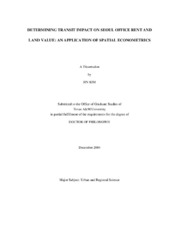| dc.contributor.advisor | Sweeney, Donald A. | |
| dc.contributor.advisor | Zhang, Ming | |
| dc.creator | Kim, Jin | |
| dc.date.accessioned | 2005-02-17T21:05:39Z | |
| dc.date.available | 2005-02-17T21:05:39Z | |
| dc.date.created | 2004-12 | |
| dc.date.issued | 2005-02-17 | |
| dc.identifier.uri | https://hdl.handle.net/1969.1/1566 | |
| dc.description.abstract | This study posits that there may be a systematic bias in measuring the transit’s
endogenous impact on land values in a built up area due to discrimination by location in
the city. Studies of transit value-added effect report mixed results about the capitalization
of station proximity. The question is not whether a transit station influences nearby
land values, but how and where location determines the impacts.
Examining 731 office rentals and land values in Seoul, this study finds that value
premium over better accessibility to a station decays with increasing distance from the
central business district (CBD) and significantly depends on the development density of
the station area. Overall, station benefits seem to exist in Seoul, but they look more
notable in centers with higher centrality. This makes a hierarchy of regression
coefficients for station proximity by location, i.e. the beta in the CBD is the highest and
those in the subcenters are next, while that in other areas is the lowest. Study findings
imply that the potential of more compact and denser developments within station areas
seems higher in a dense inner city, providing evidence for the concept of ‘compact city.’
Questions concerning model specification in the hedonic approach are raised: in
research sampled heavily from the suburbs, the coefficient may be underestimated where
this benefit actually exists. Also, due to the incongruence of station area with station
value-added area, using a dummy variable seems intrinsically risky.
This study shows that estimation with spatial models outperforms OLS
estimation in the presence of spatial autocorrelation. Also, there is a strong spatial
autocorrelation even in the SAR residuals where the omission of key variables still
influences the estimation. Overall, spatial lag and error term variables greatly improve
the fitness of regression equations; however, the latter seemed more useful than the
former in this study. One thing to note is that the latter seems more sensitive to the
choice of weight matrix than the lag variable. There may exist a unique weight scheme
proper for the data structure which cannot be known in advance. | en |
| dc.format.extent | 2120090 bytes | en |
| dc.format.medium | electronic | en |
| dc.format.mimetype | application/pdf | |
| dc.language.iso | en_US | |
| dc.publisher | Texas A&M University | |
| dc.subject | Transit impact | en |
| dc.subject | Transit-oriented development (TOD) | en |
| dc.subject | Office rent | en |
| dc.subject | Spatial autocorrelation | en |
| dc.subject | Geographic information system (GIS) | en |
| dc.title | Determining transit impact on Seoul office rent and land value: an application of spatial econometrics | en |
| dc.type | Book | en |
| dc.type | Thesis | en |
| thesis.degree.department | Landscape Architecture and Urban Planning | en |
| thesis.degree.discipline | Urban and Regional Science | en |
| thesis.degree.grantor | Texas A&M University | en |
| thesis.degree.name | Doctor of Philosophy | en |
| thesis.degree.level | Doctoral | en |
| dc.contributor.committeeMember | Ellis, Christopher D. | |
| dc.contributor.committeeMember | Graham, Charles W. | |
| dc.type.genre | Electronic Dissertation | en |
| dc.type.material | text | en |
| dc.format.digitalOrigin | born digital | en |


